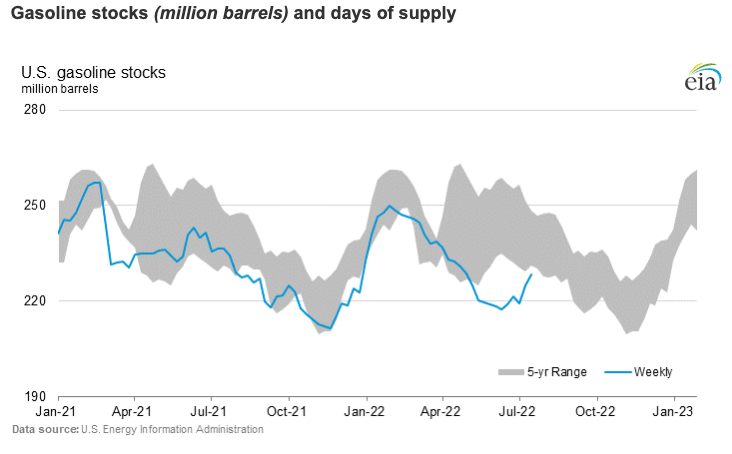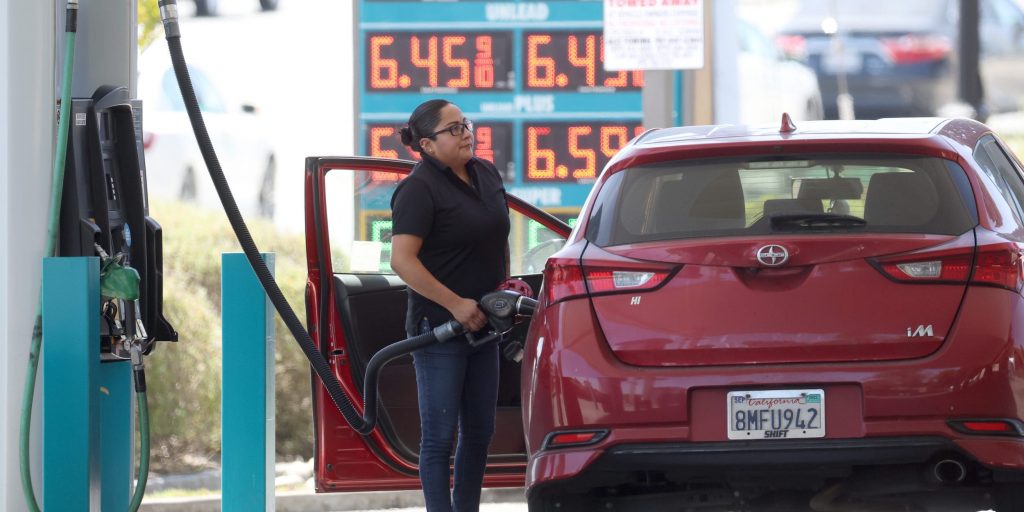- The average price of a gallon of gas is back below $4.50, but the recovery on Americans' wallets has been slow.
- Gas prices often move like "rockets and feathers," meaning they shoot higher and sink slowly.
- Several economists argue that decreased competition allows gas stations to keep prices high for longer.
It's looking a lot like the US is past the gas-price peak. Getting back to normal levels, however, won't happen so quickly.
Average gas prices have now fallen for an entire month. The nationwide average fell to $4.49 in the week that ended Monday, according to the Energy Information Administration. That's down from the mid-June peak of $5.01 and marks the lowest level since the first week of May.
Daily readings from AAA's gas-price tracker are just as encouraging. The company's national average fell roughly three cents to $4.44 on Thursday. Averages in Georgia, South Carolina, Mississippi, and Texas now sit below $4.
One Colorado gas station even sold gas for $2.99 per gallon on Tuesday, according to GasBuddy.
Just don't expect prices to fall as quickly as they rose. Gasoline is perhaps the best example of asymmetric pricing in the real world, a term that's more casually known as "rockets and feathers." The dynamic is used to describe how prices can soar higher like rockets but decline with the urgency of a falling feather. And although it's unclear what exactly is behind the trend, various signs point to "greedflation."
Blame companies that don't want to lower prices too much
The nationwide decline is a welcome relief for tens of millions of American drivers. Prices launched higher through the first half of 2022 to hit numerous record highs. Russia's invasion of Ukraine hobbled global supply chains for crude oil. That strained supply quickly clashed with drivers' sky-high demand as Americans looked to return to pre-pandemic travel.
The very factors pushing prices higher have since reversed course. Gas demand ticked higher but held below levels seen earlier in the summer, according to EIA data. Domestic gasoline stocks, meanwhile, continued an upward climb, bringing overall supply closer to typical levels.

Tumbling oil costs also pulled gas prices lower in recent weeks. West Texas Intermediate crude futures traded just below $100 per barrel Wednesday afternoon, down from the June highs of $122 per barrel. Should the downward trend hold, cheaper crude will weigh heavily on pump prices.
Though the decline is only five weeks old, the rockets-and-feathers phenomenon is clear as day. Many of the weekly increases seen in May and June are larger than the past few weeks' declines. The same dynamic can be seen in the crude oil market as well, with prices typically cooling at a much slower rate than they rally.
The trend has been chalked up to a range of factors. Some economists point to the energy industry's complex supply chain as a reason for gas stations' slow and cautious reactions to changing prices. Others argue that, since gas stations often raise prices well after oil costs climb, they leave prices high to recoup lost profits when costs swing lower.
Democrats blame gas companies' "greedflation," arguing firms are keeping prices high to boost prices. President Joe Biden has repeatedly urged gas stations to lower prices to levels that "reflect the cost you're paying for the product." Yet the relatively small number of nationwide gas companies could be delaying such relief.
The rockets-and-feathers dynamic seems to be most powerful in areas where gas stations "face relatively little competition," Nobel-prize-winning economist Paul Krugman said in a July 8 column in The New York Times, hinting that consolidation is contributing somewhat to the slower decline.
"Monopoly power isn't the principal cause of inflation, which has been driven by an overheated economy plus external shocks like Russia's invasion of Ukraine," he said. "But there's a reasonable case that monopoly power is a cause of inflation."
Several signs point to the gas-price recovery continuing in the coming weeks. But as travel season continues and lower prices lure Americans back to their cars, getting back to pre-crisis prices will likely take more than a few months.
